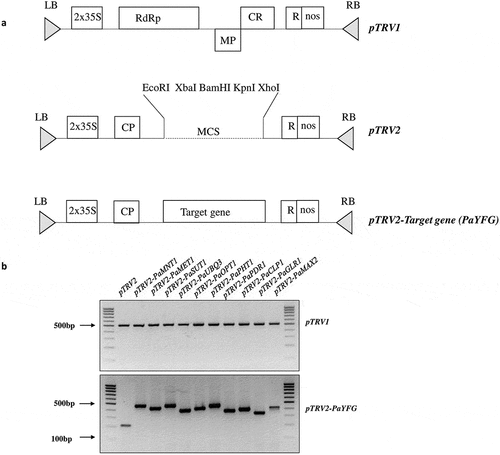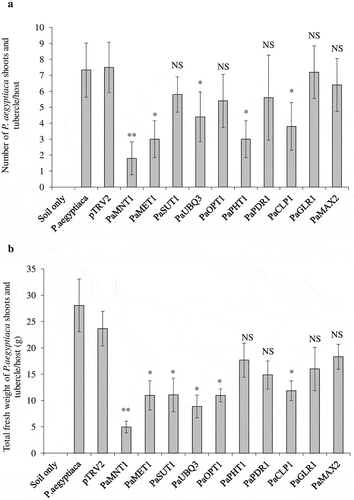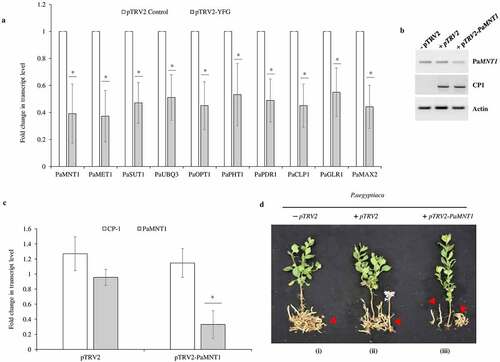Figures & data
Table 1. List of putative P. aegyptiaca genes used in this study
Figure 1. (a) Schematic representation of pTRV1, pTRV2, and pTRV2-YFG vector design used for the silencing P. aegyptiaca gene adapted from the previous studyCitation35. Abbreviations details -Left border (LB), a duplicated CaMV 35S promoter (2X 35S), 29KDa movement protein (MP), viral coat protein (CP), multiple cloning sites (MCS), Cystine rich protein (CR), 134 and 194 KDa replication protein (RdRp), self-cleaving ribozyme (R), nopaline synthase terminator (NOS-T), Right border (RB). (b) Expression of the empty plasmid pTRV1 and pTRV2 recombinant clones (pTRV2-PaYFG), in the VIGS-treated N. benthamiana plants. To confirm the infection PCR analysis of genomic DNA isolated from the leaves and roots was done 10–12 d after infection, both have given similar results.

Figure 2. Reduced germination of P. aegyptiaca tubercles grown on host root N. benthamiana. The total number of P. aegyptiaca tubercles attached to the host plants in the pot assay. Tubercles that were larger than 2 mm (diameter) were counted and weighted. The number of total parasitic tubercles (a), and the total fresh weight of tubercles (b), were analyzed. Bars represent the average ±SE (n = 5) value from two different experiments with five independent host plants. Statistical differences were calculated with Student’s two-tailed t-test (p < .05). The asterisk on the bar indicates a significant difference between the pTRV2-mediated silenced line (pTRV2-PaYFG) compared to the vector control plants (pTRV2).

Figure 3. (a) The transcript level of various pTRV2-PaYFG silencing constructs using P. aegyptiaca tubercle. The expression level of each gene is displayed after normalization with the internal housekeeping gene PaACT1. All analyses were performed using three biological replicates. Data represented as average ± SD (n = 3). The asterisk on the bar indicates a significant difference between the pTRV2-PaYFG-silenced line compared to the vector control (pTRV2) plants as determined by JMP statistic software (P ≤ .05). (b, c) The transcript level of PaMNT1, viral CP-1 in P. aegyptiaca tubercle. Expression of viral coat protein transcript acts as a control to measure the infection level. The P. aegyptiaca actin gene served as an internal control for the expression. All analyses were performed using three biological replicates. Data represented as average ± SD (n = 3). The asterisk on the bar indicates a significant difference between the PaMNT1-silenced line compared to the vector control plants as determined by JMP statistic software (P ≤ .05). (d) Effect of the P. aegyptiaca target genes PaMNT1-silenced line compared to the vector control, on development of the parasite in N. benthamiana host plants. (i) host plant infected with P. aegyptiaca only (ii) host plant infected with P. aegyptiaca and agroinfiltrated with pTRV1 and pTRV2 vector (iii) host plant infected with P. aegyptiaca and agroinfiltrated with pTRV1 and pTRV2 vector containing fragment for silencing for PaMNT1. P. aegyptiaca tubercles and shoots attached to the controls and VIGS-treated N. benthamiana plants are indicated by red arrows.

